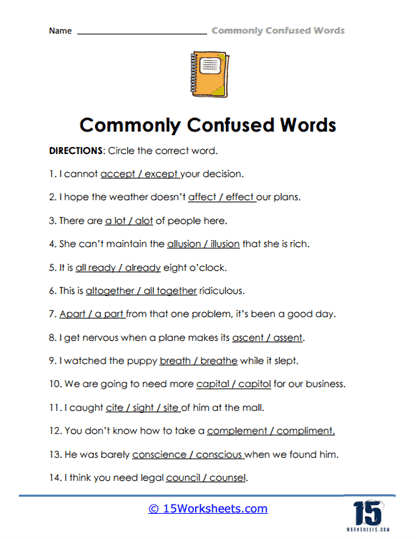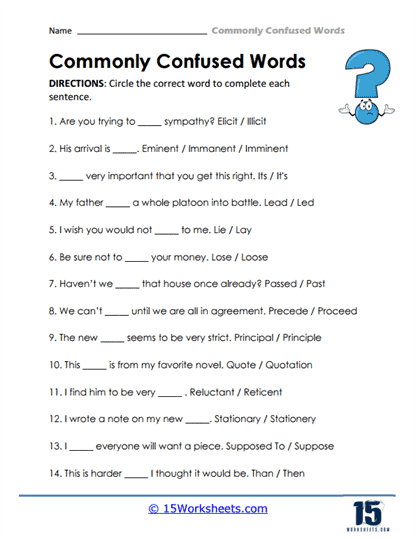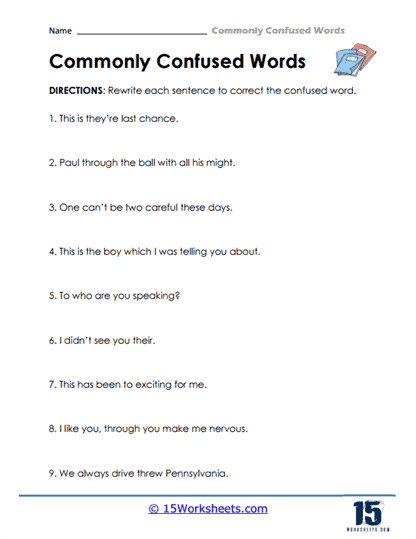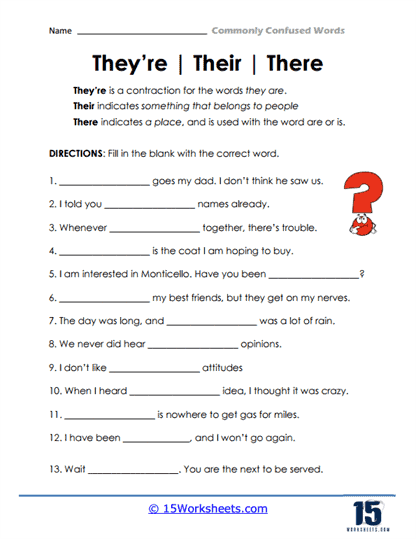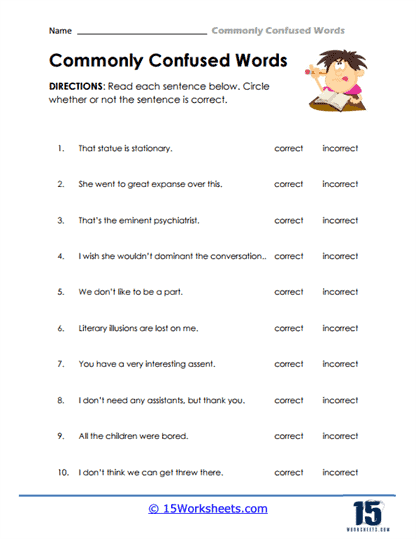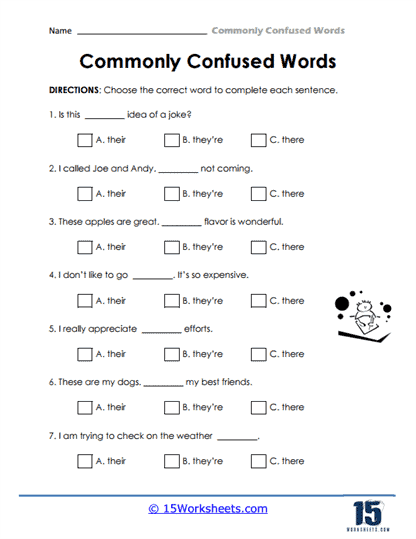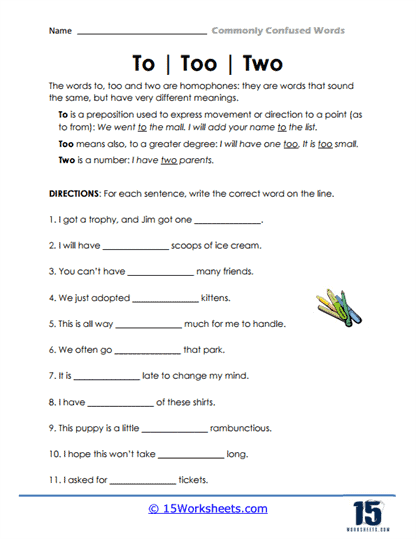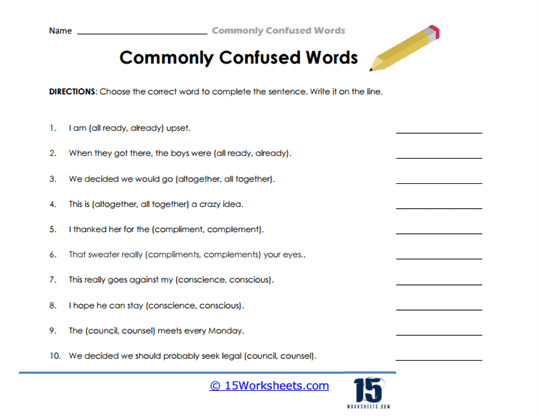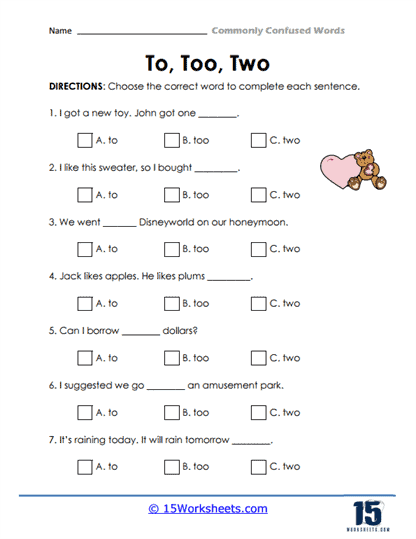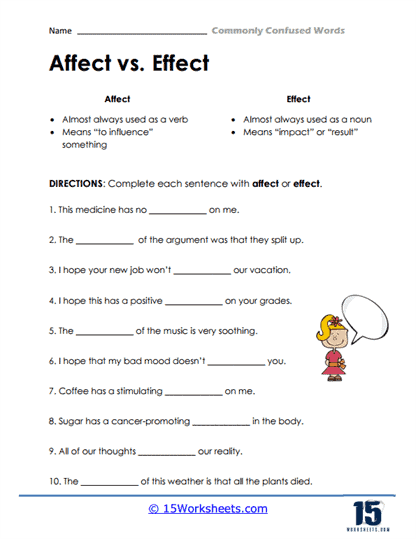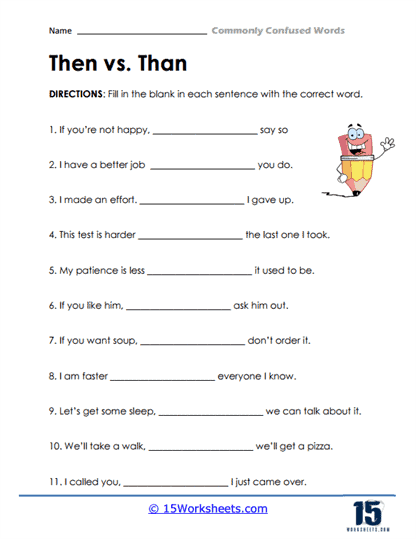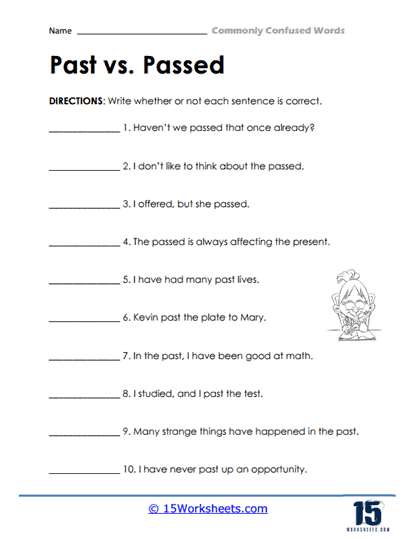Commonly Confused Words Worksheets
All About These 15 Worksheets
This series of 15 worksheets is designed to help students learn and practice commonly confused words in the English language. These exercises aim to reinforce students’ understanding of the differences between words that are similar in spelling or pronunciation, but have different meanings.
From the deceptively innocent “Pick the Word” to the delightfully infuriating “Affect vs. Effect,” students are given a crash course in word warfare. These aren’t your run-of-the-mill worksheets. Oh no. These are verbal bootcamps, designed to whip young minds into grammatical shape. Expect a few tears. Expect triumph. Expect to finally learn the difference between “past” and “passed” without spiraling into a philosophical crisis.
It all begins gently enough. “Write Ins” invites students to play God and choose the correct word to bring life to a sentence. “Where is the Confusion?” dares them to confront the enemy head-on, identifying the rogue word among seemingly innocent prose. But things escalate quickly. Enter the holy trinity of word-related despair: “They’re, Their, There” and its sequel, “Confusing: They’re, Their, There.” These worksheets aren’t just about picking the right homophone. They demand an existential commitment to understanding who “they” are, where “there” is, and whether “their” backpack is actually missing-or just emotionally unavailable.
Just when you think you’ve caught your breath, along comes “Words Use in Context” and the dreaded “A, B, or C?“-the latter a multiple-choice gauntlet designed by someone who clearly enjoys watching students doubt every word they’ve ever known. And then there’s the showdown of the century: “To, Too, or Two,” appearing not once but twice (possibly because it takes two tries to believe how often we misuse them). These exercises demand clarity of thought, a sharp eye, and, ideally, snacks. Especially for “Part 2: To, Too, or Two.” You’ll need them.
Let’s not forget the true linguistic minefields: “Affect vs. Effect,” “Than vs. Then,” and “It’s or Its.” These worksheets are perfect for students who love asking, “Why does this word hate me?” and “Is my brain leaking?” These pages are a mix of grammatical justice and psychological endurance testing. “Cite, Sight, Site” takes things further by punishing anyone who ever tried to use all three in a research paper without crying. It’s like a vision test, a geography quiz, and a plagiarism checkpoint all rolled into one.
“Sentence Completion” brings it all together with a patchwork of perilously confusing phrases, challenging students to draw on everything they’ve learned to make actual coherent thoughts. It’s a beautiful moment, really-a sort of vocabulary victory lap. These worksheets don’t just teach students how to use words correctly; they teach resilience, introspection, and the ability to laugh in the face of grammatical uncertainty. So go ahead-download, print, and prepare to battle. The war on confusion has never been so strangely satisfying.
Commonly Confused Words in the English Language
There is a whole array of commonly confused words in the English language. Some words sound similar, while others look similar. However, these commonly confused words are incredibly different in their meaning. It is essential to go through these words and the context in which they are used so that you can practice using them smoothly without making any significant mistakes or blunders in writing or speaking English.
Have a look at the following sentences:
- He slipped a beautiful ring on her finger.
- Don’t forget to wring the water from the wet t-shirt.
Here the words “ring” and “wring” sound similar, but they are very different in their meanings.
Three situations generate confusion of words in the English language. They are the differences between American and British English, words that sound alike and words that look alike.
1. American and British English Confusion
There are major differences between some words in English used in the United Kingdom and the United States.
Confusion in words in these two languages may arise because of spelling differences. For example, counsellor in Britain is written as counselor in America. In British English, -ense is used for verbs, and –ence in nouns. Whereas many nouns end in –ense in American English. For example, license is a noun in American English and a verb in British English.
Other words that represent the same objects differ in their spellings in the two versions of English. Aeroplane is written as airplane in American English. Similarly, donut is written as doughnut in British English.
2. Words That Sound Alike
Words that sound alike but have different meanings are called Homophones. They pose the biggest challenge for non-native speakers and little students in reading or writing the English language. Some
examples of homophones are:
- Effect and Affect – Effect is a noun and means a result or consequence due to a cause. Affect is a verb meaning to have an effect or make a difference on something.
- Brake and Break – Brake is a device to stop a vehicle from moving, and break means to separate something into pieces or interrupt an event.
- Desert and Dessert – Desert means to abandon a person or situation, or an arid or desolate area. Dessert refers to a sweet course eaten after a meal.
- Principal and Principle – Principal is the most senior person in an organization. Principle is a fundamental truth, theorem, or law.
- Then vs. Than – Then is an adverb that relates to time. Than is a conjunction used for comparisons.
- Accept vs. Except – Accept is a verb meaning to receive or agree. Except is a preposition meaning “excluding” or a conjunction meaning “but.”
- Complement vs. Compliment – Complement refers to something that completes or enhances something else. Compliment is an expression of praise or admiration.
- Stationary vs. Stationery – Stationary is an adjective meaning not moving or fixed in one place. Stationery refers to writing materials, such as paper and envelopes.
- Lose vs. Loose – Lose is a verb that means to misplace or fail to win. Loose is an adjective meaning not tight or not securely fastened.
3. Words That Look Alike
Homographs are words that have the same spelling but completely different meanings. They might have different pronunciations, but when
written on paper, they may cause some major confusion if you do not know the context in which the word has been used.
- Bat – Bat refers to the baseball equipment that is used to hit the ball. Bat also means the winged nocturnal animal that hangs upside down on a tree to sleep.
- Wind – Wind is the natural flow or movement of air in the environment, or it also means taking a twisted or spiral course around something.
- Pen: Pen is an instrument to write or draw, and it is also used to refer to an enclosure on a farm in which animals like sheep are kept.
- Blue – Blue is the color of the sky and sea, but it also represents a melancholy or sad mood of a person.
4. Contractions
Contractions are shortened forms of words or phrases in which specific letters or sounds have been omitted and replaced by an apostrophe. Contractions are commonly used in informal speech and writing in the English language to create a more casual tone or to convey information more concisely.
- Your vs. You’re – Your is a possessive pronoun, showing ownership. You’re is a contraction of “you are.”
- Its vs. It’s – Its is a possessive pronoun, indicating ownership. It’s is a contraction of “it is” or “it has.”
- Their vs. There vs. They’re – Their is a possessive pronoun. There is an adverb indicating location. They’re is a contraction of “they are.”
Practice Is the Key
The only way to get a hold of these commonly confused words is to practice reading, writing, and learning the meaning of these words and the proper context in which they are used in English.
Worksheets, daily classroom activities, and educational games are very helpful in learning these words or teaching them to your
students.

